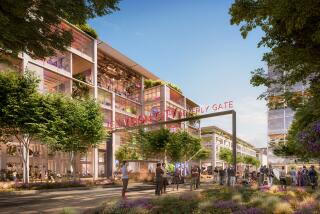L.A.’s Olvera Street : Political Battle Rages Over Plan to Upgrade Tattered Tourist Spot
- Share via
LOS ANGELES — When Christine Sterling proposed the creation of Olvera Street, she envisioned a marketplace and tourist attraction that would pay homage to the city’s Mexican population and preserve a sliver of the downtown sector where Los Angeles was founded in 1781.
“The creation of such an international trade center would furnish Los Angeles with the greatest tourist attraction she may ever have,” the fourth-generation Californian told civic leaders back in 1926.
At Sterling’s death in 1963, the aging collection of restaurants, curio shops and historic buildings had become the focal point for the city’s celebrations of Mexican holidays. It also had become a tangible link to Mexico for Mexicans proud of their heritage.
But Sterling would probably shake her head at Olvera Street’s plight these days.
A political battle over the future of the popular tourist spot is threatening to split segments of the Latino community. The fight is over a face lift that everyone agrees the aging tourist attraction needs. It pits most of the street’s 79 merchants, who are descendants of the street’s founders, against City Councilman Richard Alatorre, a powerful political force on the Eastside.
The merchants want a major say in the pending project, while Alatorre, whose 14th District includes Olvera Street, believes that a developer independent of the merchants may be better able to upgrade the deteriorating marketplace.
Latino leaders say it is a battle that they would like to see avoided. Said one: “I see no good use in seeing Latinos fighting each other. But, on the other hand, we are talking about one of the most Mexican things in Los Angeles.”
The dispute sharpened last month when the East Los Angeles Community Union, commonly called TELACU, was granted an $1,800-a-month lease to run a catering business out of Olvera Street as an extension of its posh Tamayo restaurant.
Outside Developer
Some merchants now fear that TELACU, a politically well-connected nonprofit development corporation on the Eastside, could eventually become the outside developer to take over Olvera Street.
The merchants worry that TELACU, which has developed a large industrial park and other high-tech enterprises, might turn Olvera Street into an over-commercialized Mexican “shopping mall,” spoiling its quaintness and Latino authenticity.
TELACU officials argue that theirs is one of the few minority corporations that could pull off a project as large and sensitive as Olvera Street.
The Los Angeles Parks and Recreation Commission granted the lease to TELACU over the objections of the Olvera Street Merchants Assn., which represents most businesses on the street, and an advisory committee that helps the city run El Pueblo de Los Angeles State Historic Park where Olvera Street and the Avila Adobe, the city’s oldest structure, are located.
Vivien Bonzo, president of the merchants group, said she opposed the agreement because the catering business would be unfair competition for the eateries already in Olvera Street--including the La Golondrina restaurant that her grandmother founded in 1930 across the walkway from what is now TELACU’s catering operation.
Only a Subplot
The lease is but one subplot in the larger fight over the future of Olvera Street, which was founded in 1929, three years after Sterling proposed it. Although Olvera Street attracts nearly 2 million visitors a year, little has been done to restore its old buildings. And in recent years, merchants have found it increasingly difficult to turn a profit. Many buildings do not meet earthquake standards and fire officials have expressed concern about access in case of an emergency.
In 1987, the merchants paid for a $100,000 study that detailed Olvera Street’s most pressing needs.
Among them were a new 500-car parking structure, new construction to replace some aging buildings, a multimedia visitors center, a pedestrian walkway between the street and Union Station, and the closing of Main Street on weekends and for special events.
City officials say the work cannot start until the city assumes ownership of El Pueblo park, which it has administered for the state since 1974. The state has deeded the land to the city but minor legal technicalities have held up the transfer, a tangle that may not be resolved for another year.
Guidelines Missing
A $20-million to $30-million redevelopment project has been proposed by the merchants to spruce up Olvera Street, but guidelines for the project have yet to be released by the city administrative officer.
At this point, it is not clear which city agency will oversee the park’s operation and the proposed Olvera Street redevelopment. The City Council, where Alatorre wields influence on matters involving the Eastside, will have the final say on choosing a developer.
More to Read
Sign up for Essential California
The most important California stories and recommendations in your inbox every morning.
You may occasionally receive promotional content from the Los Angeles Times.










